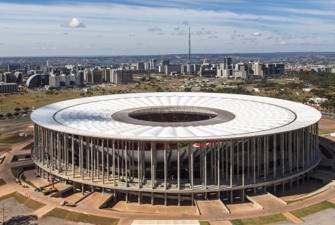Brazilian stadium legacy may end up below international average
The legacy of the 12 new or refurbished stadiums for the 2014 FIFA World Cup in Brazil will all fall below international average if nothing is done to strengthen the plans for their after-use.
If attendance figures of today do not increase dramatically from now and until 2014, the sporting legacy of the 12 Brazilians stadiums built or refurbished for the FIFA World Cup will end up below the international average for similar stadia, and some of Brazils state-of-the-art stadiums will qualify as ‘white elephants’.
This can be concluded on the basis of projections made by the Danish Institute for Sports Studies (Idan) on the occasion of the Play the Game day 24 October in São Paulo.
Building on the methodology used in the World Stadium Index from 2011 which included 75 stadiums from 20 countries, IDAN has made estimates of the after-use of the 12 new or rebuilt stadiums that Brazil is constructing for the FIFA World Cup on a budget summing up to 1.1 billion US-dollars.
If the projections come true, not one of the 12 stadiums in Brazil will reach the international average of 13.4 points – which means that in the course of one year, a stadium will welcome audiences in numbers corresponding to 13.4 times its seat capacity.
Unlike the World Stadium Index, which is based on historical facts and includes not only sporting, but also religious and cultural events at the relevant stadiums, the projections are only based on available attendance figures of the national league and national cup tournament for the football clubs that will eventually become main tenants of the World Cup stadia.
Plan for the after-use of stadiums must be strengthened Even so, the projections send a very clear message to the Brazilian tax-payers:
Plans for the after-use of the stadiums must be strengthened in order to ensure the sporting and economical sustainability of the stadiums.
Especially four stadiums are likely to be under-utilised and experience a problematic legacy: The new-built Arena Amazônia in Manaus, Arena Pantanal in Cuiabá and Estadio das Dunas in Natal, as well as the refurbished Estádio Nacional de Brasília in Brasilia.
The stadium in the capital Brasilia will host the opening game and have a capacity of 70,064 while the other three stadiums will have a capacity of about 42,000 – all in line with the requirements from FIFA. However, the rules set externally by FIFA are not in harmony with the future internal demand when the event is over; the audience base is much too small.
The current anchor tenants of the four stadiums are clubs in Serie B, C and D, in which the average attendance ranges from 2,000 to 5,600 spectators. Even in the cases where several clubs share a stadium, it seems impossible that they can gather sufficient audiences.
Even though Estádio Nacional de Brasília will focus on concerts and major cultural events, there are few events that can attract 60,000-70,000 people on a weekly or even a monthly basis.
Some stadiums will do reasonably well, especially when the anchor tentant is a Serie A club. The Brazilian Série A had an average attendance of 15,119 in 2011(worldfootball.net 2011). For instance, Sport Club Corinthians Paulista, which is supposed to play its future games at the new Arena de São Paolo, had during 2011 an average of 29,951 and a total of 569,061 spectators in the league (ibid) which will secure a relatively positive legacy.
Read Brazilian member of congress and former national football star Romàrio’s comments on Play the Game’s Brazilian stadium legacy research, where he urges the Brazilian government to follow the discussions during the Play the Game day.

